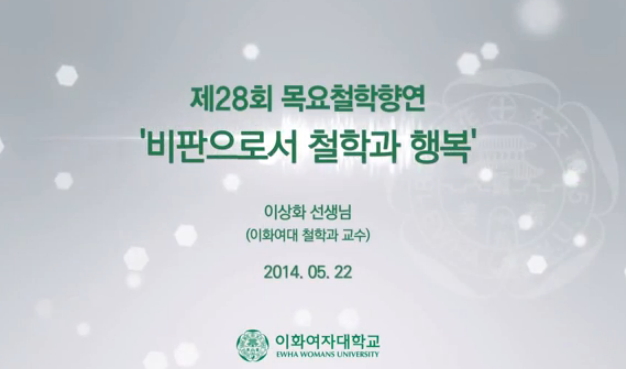Among many western philosophers, Nietzsche was a philosopher who reasoned flitting over oriental view of art, especially showing heavy Buddhist color. This research is to explore Nietzsche's oriental thought, and the meaning of Korean dance based on h...
http://chineseinput.net/에서 pinyin(병음)방식으로 중국어를 변환할 수 있습니다.
변환된 중국어를 복사하여 사용하시면 됩니다.
- 中文 을 입력하시려면 zhongwen을 입력하시고 space를누르시면됩니다.
- 北京 을 입력하시려면 beijing을 입력하시고 space를 누르시면 됩니다.
부가정보
다국어 초록 (Multilingual Abstract)
Among many western philosophers, Nietzsche was a philosopher who reasoned flitting over oriental view of art, especially showing heavy Buddhist color. This research is to explore Nietzsche's oriental thought, and the meaning of Korean dance based on his artistic thoughts.
Nietzsche's oriental reasoning of Buddhist thought was most Korean, an art world pursued by Nietzsche. Therefore, exploring Nietzsche's oriental view on art and the meaning of Korean dance which supports such logic is summarized as follows.First, Nietzsche suggests Buddhism as a conquest towards new future as philosophy which affirms life and the realities of life. He informs a method of caring the spirit to be relieved of pain, and such conquest unites with eternal recurrence thought relating to the reliance on power. His present view of human is a view of the world transcending‘human and nature’ dichotomy, and recognizes Übermensch conquering difficult situations as Buddha in Buddhism.
Second, Korean philosophical thought is a meeting and parting under a harmonious relation, a view of human to achieve peace and harmony through self-conquest and recovery to human's good nature based on practice of Buddhism or Confucianism. The Dangun, the founding father of the Korean nation, mythology and humanitarianism is an anthropocentric view of the world which takes a serious view of human world towards the present world. Korean's consciousness structure is based on practice of humanism, populism, mutual respect, equality, and secularism. It is not a traditional dichotomist structure of the west which separates the view of human and the view of nature from one another, but identical with Nietzsche's monistic structure which shares identical logical connection.Third, the image of curve in Korean dance depicts circulating cosmologic meaning, intervening and circulating between human and human, human and nature, reality and transcendental world, and present and future. Han(恨), Korean emotion consisting of grudge, hate, regret, sadness, grief, and heartburning, is a remaining hope, which transcends a simple sadness, towards a creative world of‘creation’ and‘drive’, sublimating to the world of ideal and delight. Unlike western dance which emphasizes on a strong desire of expressing individuality, technical skill, and material, Korean dance emphasizes internal suppression and peace, and revelation skill which recognizes spiritual subject through concentration on the inside. Breathing in Korean dance, the midway connecting the heavens and the earth, using human body as the core, is a typical Korean dance technique which is scientific and philosophic as it is.Lastly, Korean dance for Nietzsche is a creative principle towards a new world as reliance on power. Nietzsche's‘funambulist’, a metaphor towards the transcendental world with human as the central figure, is a typical theme of Korean dance. Up and down movement in space and time, filling and emptying, and tying and untying are also Korean expression of life and death, creation and destruction, pain and hope, and comedy and tragedy. Nietzsche's Übermensch is‘the one who dances’, a dancer who has a strong will, and is not subordinate to exterior conditions. Moreover, Buddhist doctrine and view of the world, that is, coming into being and changed Dionysus' Nirvana world is identical to Korean dance which comprehends emotion of Koreans who live free and creative lives.
국문 초록 (Abstract)
서양 철학자 가운데 니체는 특히 불교적 색채를 농후하게 보이며, 동양적 예술관을 넘나들며 사유한 철학자이다. 이 연구는 니체의 동양적 사상을 탐색하고 그 속에서 나타나는 그의 예술사...
서양 철학자 가운데 니체는 특히 불교적 색채를 농후하게 보이며, 동양적 예술관을 넘나들며 사유한 철학자이다. 이 연구는 니체의 동양적 사상을 탐색하고 그 속에서 나타나는 그의 예술사상을 바탕으로 한국무용의 의미를 탐색하는데 목적이 있다. 니체의 불교사상에 대한 동양적 사유는 가장 한국적이었던 것으로, 바로 니체가 추구하는 예술세계였다. 따라서 이러한 논리를 뒷받침할 수 있는 니체의 동양적 예술관과 한국무용의 의미 찾기는 다음과 같이 집약할 수 있을 것이다. 첫째, 니체는 불교를 삶과 현실을 긍정하는 철학으로서 새로운 미래에 대한 극복으로 제시한다. 삶의 고통을 벗어나는 정신 섭생의 방법을 알려주고, 이러한 극복은 힘에의 의지와 관련하여 영원회귀사상으로 교합된다. 그의 현시적인 인간관은‘인간과 자연’이라는 이분법을 넘어선 세계관으로 생·노·병·사의 어려운 상황을 극복하는 위버멘쉬(Übermensch 초인, 극복인)를 불교의 부처로 인식한다. 둘째, 한국 철학사상은 조화로운 관계 속에서의 이합집산으로, 불교나 유교의 실천성을 근본으로 한 인간의 선한 본성에로의 회복과 자기극복을 통한 평화와 안녕을 달성하고자 하는 인간관이다. 특히 단군신화와 홍익인간은 현세에 대한 인간세계를 중시하는 인간중심주의의 세계관이다. 따라서 한국인의 의식 구조는 인본주의, 대동주의, 상호존중, 평등, 현세주의적 이념의 실천을 기저로 한다. 인간관과 자연관이 서로 분리되는 전통적인 서양의 이원론적인 구조가 아닌, 동일한 사상적 맥을 같이 하는 니체식의 일원론적인 구조와 동일한 것이다. 셋째, 한국 무용에서 곡선의 이미지는 순환하는 우주론적 의미를, 인간과 인간을, 인간과 자연을, 현실과 초월세계를, 현재와 미래를 끊임없이 매개하며 순환한다. 우리 민족의 정서인 한(恨)은 단순한 슬픔을 넘어선 이상과 환희의 세계로 승화되는 ‘생성’과 ‘충동’의 창조적 세계에 대한 여망이다. 한국 춤은 개성 표현에 대한 욕망이 강한 서양 춤과는 다르게 내면적 평정과 평화를, 기교나 재료보다는 내면으로의 주의집중에 의한 대상의 정신적 실체를 인식한 현시적 능력을 강조하는 춤이다. 한국무용에서의 호흡은 사람의 몸이 중심이 되어 하늘과 땅의 중간 접점을 이어주는 대표적인 한국무용의 기교로서 그 자체가 과학적이고 철학적이라 할 수 있다. 마지막으로 니체에게 있어서 한국의 무용은‘힘에의 의지’로서 새로운 세계에 대한 창조적 원리이다. 니체의‘줄 타는 광대’는 인간을 중심으로 하는 초월적 세계에 대한 비유로서 한국무용의 대표적인 주제이다. 시공간의 상하 움직임, 채움과 비움, 맺음과 풀림은 삶과 죽음, 창조와 파괴, 고통과 희망, 희극과 비극의 한국적 표현이기도 하다. 니체의 위버멘쉬는‘춤추는 자’로서 의지가 강하고 외부 여건에 종속되지 않는 무용가이다. 또한 불교의 교리와 세계관, 즉 생성 변화하는 디오니소스의 열반 세계는 자유롭고 창조적인 삶을 사는 한국인의 정서를 담은 한국무용과 일치하는 내용이다.
참고문헌 (Reference)
1 정신문화연구원, "홍익인간 이념의 전개와 그 정치적 함의" 22 (22): 1999
2 채희완, "한국 춤의 정신" 1999
3 강용수, "존재의 가벼움을 위한 철학.니체전집KGW Ⅳ2,Ⅳ3" 책세상 2005
4 조요한, "예술철학" 미술문화 2003
5 김말복, "역사 속의 춤" 이화여자대학교 출판부 2001
6 봉은사 출판부, "에세이 불교개론" 봉은사 출판부 1991
7 심경희, "살풀이 춤"
8 김대경, "비극의 탄생" 청.하 2002
9 양영란, "불교와 서양의 만남" 세종서적 2002
10 안영길, "미학예술학사전" 미진사 1989
1 정신문화연구원, "홍익인간 이념의 전개와 그 정치적 함의" 22 (22): 1999
2 채희완, "한국 춤의 정신" 1999
3 강용수, "존재의 가벼움을 위한 철학.니체전집KGW Ⅳ2,Ⅳ3" 책세상 2005
4 조요한, "예술철학" 미술문화 2003
5 김말복, "역사 속의 춤" 이화여자대학교 출판부 2001
6 봉은사 출판부, "에세이 불교개론" 봉은사 출판부 1991
7 심경희, "살풀이 춤"
8 김대경, "비극의 탄생" 청.하 2002
9 양영란, "불교와 서양의 만남" 세종서적 2002
10 안영길, "미학예술학사전" 미진사 1989
11 김말복, "무용예술의 이해" 이화여자대학교출판부 2004
12 김경자, "무용미학" 현대미학사 2000
13 박이문, "니체의 철학과 동양철학: 초인의 동양적 조명" 33 (33): 2000
14 박미영, "니체의 예술론에 나타난 무용의 창조성" 대한무용학회 47 (47): 75-92, 2006
15 김정현, "니체의 몸 철학" 문학과 현실사 2000
16 강용수, "니체의 『차라투스트라는 이렇게 말했다』의 밧줄에 대한 은유적 해석 - 춤의 공간적 구조에 대한 분석을 중심으로" 한국니체학회 12 (12): 171-199, 2007
17 강영계, "니체와 예술" 한길사 2000
18 이진우, "니체와 아시아적 사유 2 - 니체의 불교관을 중심으로 -" 대한철학회 85 : 273-294, 2003
19 김정현, "니체와 불교의 만남; 니체의 불교 이해 및 서양의 무아(無我)사상을 중심으로" 한국니체학회 (8) : 63-97, 2005
20 박은영, "궁중정재의 시대적 변천과 철학성 연구" 한양대학교 2006
21 Robert G.Morrison, "Nietzsche and Buddhism" Oxford University Press 1997
22 정동호, "Also sprach Zarathustra. 차라투스트라는 이렇게 말했다. 니체전집KGW Ⅵ1" 책세상 2005
동일학술지(권/호) 다른 논문
-
- 한국체육철학회
- 김옥태
- 2008
- KCI등재
-
불교와 들뢰즈의 주체 개념과 무용현상 안에서의탈 주체화에 대한 관계적 의미고찰
- 한국체육철학회
- 김정은
- 2008
- KCI등재
-
다문화 사회 속의 초등무용교육: 변화를 위한 모색:포크댄스(Folk Dance)를 중심으로
- 한국체육철학회
- 이정연
- 2008
- KCI등재
-
- 한국체육철학회
- 안용규
- 2008
- KCI등재
분석정보
인용정보 인용지수 설명보기
학술지 이력
| 연월일 | 이력구분 | 이력상세 | 등재구분 |
|---|---|---|---|
| 2022-04-27 | 학회명변경 | 영문명 : Korean Society for the Philosophy of Sport, Dance & Martial Arts -> Korean Society for the Philosophy of Sport, Dance, and Martial Arts |  |
| 2022 | 평가예정 | 재인증평가 신청대상 (재인증) | |
| 2021-12-04 | 학술지명변경 | 외국어명 : Philosophy of Movement : Journal of the Korean Society for the Philosophy of Sport, Dance & Martial Arts -> Philosophy of Movement : The Journal of the Korean Society for the Philosophy of Sport, Dance, and Martial Arts |  |
| 2019-04-24 | 학회명변경 | 영문명 : Korean Philosophic Society For Sport And Dance -> Korean Society for the Philosophy of Sport, Dance & Martial Arts |  |
| 2019-01-01 | 평가 | 등재학술지 선정 (계속평가) |  |
| 2018-12-01 | 평가 | 등재후보로 하락 (계속평가) |  |
| 2018-03-31 | 학술지명변경 | 외국어명 : Philosophy of Movement : Journal of Korean Philosophic Society for Sport and Dance -> Philosophy of Movement : Journal of the Korean Society for the Philosophy of Sport, Dance & Martial Arts |  |
| 2015-01-01 | 평가 | 등재학술지 유지 (등재유지) |  |
| 2011-01-01 | 평가 | 등재학술지 유지 (등재유지) |  |
| 2009-01-01 | 평가 | 등재학술지 유지 (등재유지) |  |
| 2006-06-26 | 학술지명변경 | 외국어명 : Philosophy of Movement : The Journal of Korean Philosophic Society for Sport and Dance -> Philosophy of Movement : Journal of Korean Philosophic Society for Sport and Dance |  |
| 2006-01-01 | 평가 | 등재학술지 선정 (등재후보2차) |  |
| 2005-01-01 | 평가 | 등재후보 1차 PASS (등재후보1차) |  |
| 2003-01-01 | 평가 | 등재후보학술지 선정 (신규평가) |  |
학술지 인용정보
| 기준연도 | WOS-KCI 통합IF(2년) | KCIF(2년) | KCIF(3년) |
|---|---|---|---|
| 2016 | 1.05 | 1.05 | 1.09 |
| KCIF(4년) | KCIF(5년) | 중심성지수(3년) | 즉시성지수 |
| 1.21 | 1.16 | 0.947 | 0.17 |




 KCI
KCI DBpia
DBpia






